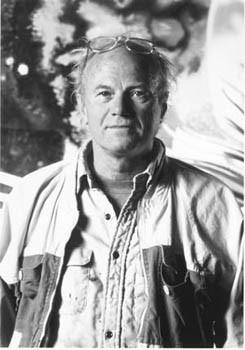James Rosenquist
Visual Artist

1933 - 2017
Inducted in 2001
Biography
Considered one of the preeminent artists of the pop art movement that emerged in the 1960s, James Rosenquist is regarded as one of the most famous visual artists in the world. He began his career as a commercial sign painter, painting large-scale billboards in the Mid-west and New York. He created unusually large, vivid and often surreal works that continue to set new horizons in the art world.
James Albert Rosenquist was born in 1933 in Grand Forks, North Dakota in the heart of the Great Plains. The only child of parents who shared a passion for flying (his mother also was a talented artist), he grew up in Minneapolis where his parents moved when he was nine. His extraordinary talent for drawing was apparent early on, and in junior high school he won a scholarship to the Minneapolis School of Art.
After high school, he spent two years at the University of Minnesota, working summers as painter for an outdoor advertising company. He learned techniques for painting large signs on such "canvases" as municipal water tanks, grain elevators and billboards. In 1955, he left the Midwest for good when he was offered a scholarship to the venerable Art Students League in Manhattan. He helped support himself by turning to his experience in outdoor commercial art, joining a local sign-painting union. Before he quit his day job for good in 1960, Rosenquist had painted huge signs throughout Manhattan, including Times Square–and also had barely escaped a 12-story fall from scaffolding suspended over the streets of Brooklyn.
Combining his commercial painting skills and inspiration from images drawn from popular culture, Rosenquist set a course for a future as a serious artist. He began the first of a series of major works that blended advertising art with fragmented, surreal images that often cast America's consumer culture in a sardonic light.
After moving into a loft studio in lower Manhattan, his neighbors included many figures who would become–as he would–icons in the nascent pop art movement. In group shows at the Museum of Modern Art and at the Guggenheim Museum, Rosenquist's paintings hung next to works by Andy Warhol, Jasper Johns, Roy Lichtenstein, Robert Rauschenberg and many other up-and-coming young artists.
Such exposure brought him to the attention of famed architect Philip Johnson, who commissioned him to paint a 20-foot by 20-foot mural for the 1964 World's Fair, held in New York City. In 1964, Rosenquist signed on with New York's elite Leo Castelli Gallery, launching a 30-year relationship that brought him worldwide acclaim from exhibits the gallery held around the globe.
In 1965, Rosenquist created what would become his iconic masterpiece, F-111, an enormous (10-foot by 86-foot) painting that wrapped around four walls of the Castelli Gallery. Consisting of 23 sections, the painting was a political commentary on the Vietnam War, just as the first U.S. Troops joined the conflict. In 1986, F-111 became the largest artwork ever sold by New York's Sotheby's auction house, fetching $2.09 million. (Since 1996, the painting has been part of the permanent collection of the Museum of Modern Art).
During the next decade, along with his productivity Rosenquist's fame soared. In 1976, he began construction of a studio and home in the small village of Aripeka, Florida, situated on the Gulf coast above St. Petersburg, where he created two murals commissioned by the Florida Legislature for permanent installation in the state's new capitol building. A vocal proponent of artists' rights, in 1978 Rosenquist was appointed by President Jimmy Carter to a six-year term on the National Council of the Arts.
In the early 1980s, Rosenquist greatly expanded his Aripeka complex by adding two steel-constructed studios large enough to accommodate his over-sized artwork. Since 2000, Rosenquist's career has been feted by a series of one-man exhibits around the country, along with another major retrospective that toured the world beginning in 2003. Consequently, he was decorated by the governments of Spain, France, Italy and Japan for his contributions to universal culture.
Tragedy struck in April 2009 when a brush fire swept the Aripeka community and destroyed the house Rosenquist shared with wife Mimi Thompson, his studios, a warehouse and all the artwork on his property, including a 24-foot by 133-foot mural commissioned by the French government.
Despite this horrific loss, later that same year Rosenquist finished his autobiography, Painting below Zero: Notes on a Life in Art (Dalton), which met enthusiastic reviews. Author Robert Hughes called the book a "frank, funny, truthful, ironic and in every way an entertaining account" that should "be read by anyone who wants to understand the last half-century of (America's) visual culture, high, low and in between."
Related Links
- Official website - http://www.jimrosenquist-artist.com/
- James Rosenquist on Wikipedia

